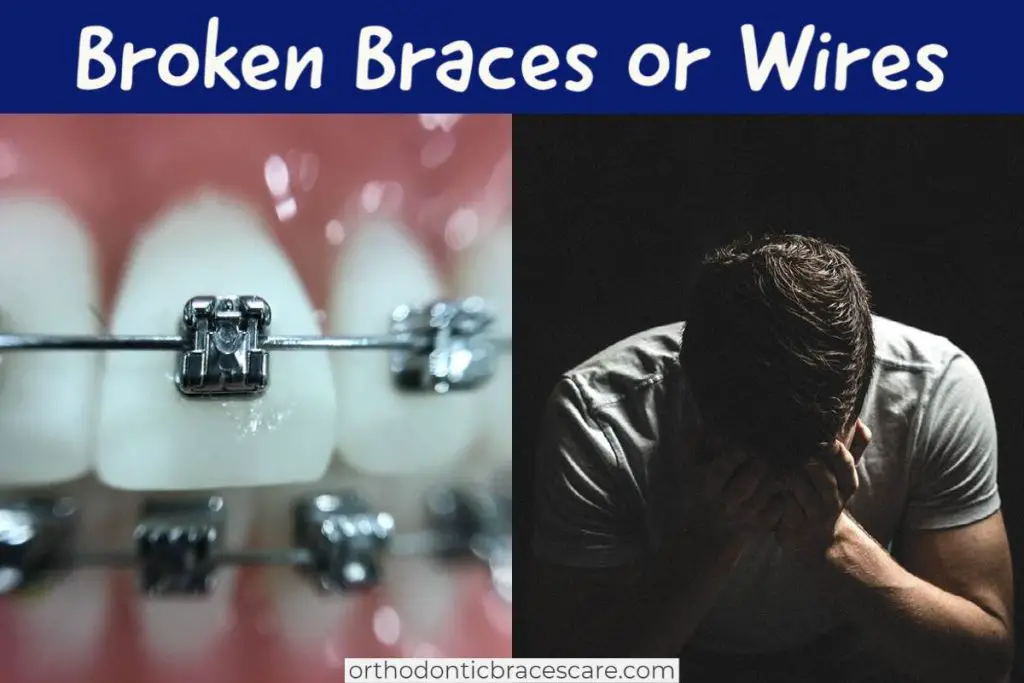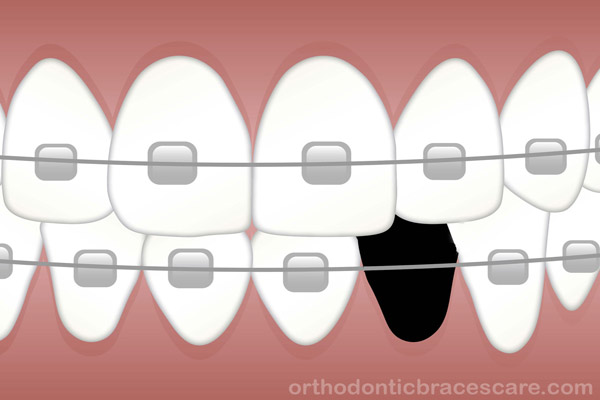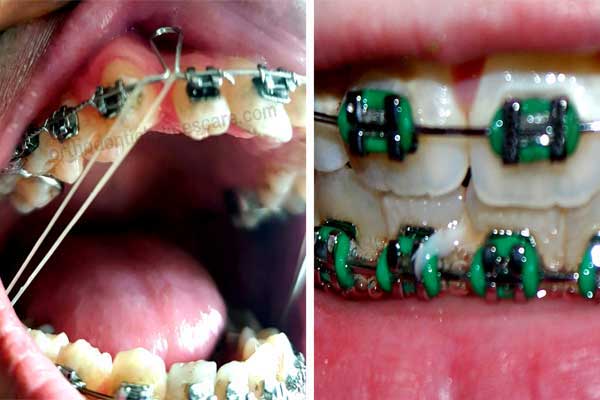During orthodontic treatment, you have to face many problems such as loose or broken braces wire, brackets, elastics, springs, and others. What happens when your braces wire breaks?
Broken braces or wire can rub or poke your cheek, tongue, or gums. They can also cut your mouth or cause it to bleed. Moreover, this may interrupt tooth movement in some cases and delay the treatment. So, you need to get them fixed to prevent further damage.
In these articles, we have discussed in detail the common problems with braces and the causes and solutions of them.
Common problems with braces, wires, elastics, and their components

While wearing braces, you may face the following problems with brackets, wires, bands, rubber bands, power chains, springs, and elastics:
- Loose braces brackets
- Broken braces bracket or floating bracket
- Loose bands
- Broken Braces Wire
- Protruding or popped out Braces Wire
- Braces wire poking back of the mouth or cheek
- Braces wire comes out of the bracket slot
- Cuts or sores in mouth from broken braces wire or new braces
- Broken coil springs
- Slip out or broken forsus appliance
- Loose spacers or separators
- Broken Braces Rubber Bands
- Slip out or Broken power chain braces
Let’s know in detail with causes and what to do.
What happens when your braces wire breaks and what to do?
Loose braces brackets
The main component of braces is the brackets. Your orthodontist attached the brackets to your teeth. This helps put pressure on your teeth when the wire is placed and tightened with it.
The orthodontist uses a special type of glue or resin to fix these metal or ceramic brackets to your teeth. While wearing braces, the glue may become weak sometimes.
So, braces brackets may get loose. This starts to poke your cheek, gums, and tongue.
Usually, it can occur when your teeth feel excess pressure may be due to biting on hard foods or getting hurt when you brush your teeth.
What to do
If you have a loose bracket, put some wax to hold it in place to prevent the sharp edge of the bracket from hurting your mouth. After that, you must visit the orthodontist to fix it.
Learn how to fix loose braces wire.
Broken braces bracket or floating bracket
Sometimes, the braces bracket may come off your teeth. As they are connected to each other by the archwire, a bracket becomes floating when it comes off your tooth. It may happen because of an injury or not following instructions given by your orthodontist.
Know why braces brackets keep coming off again and again. Normally it doesn’t affect the activity of other brackets. It doesn’t cause any pain if you can prevent it from hurting your mouth.
What to do
If brackets still stay on the wire but stick out and rotate on it, use a sterile tweezer to place the bracket in the right direction and place where it was before. If it’s loose or rubs your cheek, apply dental wax over it.
Without doing it, the bracket may hurt your mouth or you swallow it while eating. However, you must set an appointment with your orthodontist to repair it as soon as possible.
Loose braces band
Bands are placed on your molar teeth. They are made of metal rings that encircle your teeth and attached to them with the help of dental cement or resin. But, in some situations, a band may get loose.
Rarely, it can come off your teeth completely. Injury, biting on hard foods, or the wrong technique of toothbrushing can cause this problem.
What to do
Visit your orthodontist to fix the loose band. He or she will recement and reattach it. Don’t try to place the band on your own, if it comes off your teeth. Keep it safe and bring it to your orthodontist.
Broken Braces Wire
Sometimes, the wire of your braces gets broken due to any injury or becoming careless while eating or cleaning your teeth. If you don’t fix the wire, it may poke the soft tissue of your mouth. This may cut it and cause it to bleed. Moreover, it can’t move your teeth.
What to do
Use the fingernail clippers to cut off the sharp edge of the wire and put some dental wax to cover the area to protect your mouth.
Learn how to put wax on braces.
While cutting, prevent the broken part of the wire from getting swallowed accidentally. Hold the wire with your finger using tissue paper. But, you must visit your orthodontist’s office to fix it permanently.
Protruding or popped-out braces wire
During braces treatment, you get 2 types of wires. One is the archwire that runs through all brackets and the other is the single thin wires that are attached to each bracket individually. Wires are tightened to put pressure on teeth.
This moves your teeth to the desired place. Archwire ends behind the molar teeth. So, after a few times, when the tooth moves it may get popped out or protrude from the last bracket.
On the other hand, thin wires may also pop out due to teeth movement or other causes like an injury, poor tooth cleaning technique, or bad food habits.
Sometimes, it may happen when there is an excess wire. Popped-out wire hurts your cheek and tongue if you don’t repair it.
What to do
Wash a pair of fingernail clippers and cut the protruded wire. You can also use a tweezer to push the wire away from the soft tissue.
Q-tips or Pencil erasers can do the trick as well. Put an orthodontic wax to cover the affected area. Consult with your orthodontist to fix the problem forever.
Learn how to fox popped out braces wire.
Braces wire poking back of mouth or cheek
When an archwire or thin wire gets popped out and you do nothing with it, it pokes your soft tissue out of the mouth. As the archwire gets protruded behind the back tooth, it pokes the back of the mouth or cheek.
When a thin wire becomes poking if you poke your cheek, tongue, or gums. This causes pain and swelling in your mouth.
If it continuously hurts, it may cut your mouth and cause it to bleed. You can’t eat, speak, or move your mouth freely as well.
Know why you get a poking braces wire.
What to do
If the poking braces wire, cut your cheek or gums, you can rinse your mouth with lukewarm saltwater. If it causes a sore mouth, use over-the-counter oral numbing gels. But, if you don’t prevent the wire from hurting you, it won’t work.
So, use fingernail clippers to cut the pokey edge of the wire, use tweezers or a pencil eraser to move it back away from your soft tissue, or put wax on the affected area. However, you may need to visit your orthodontist to repair it permanently.
Learn how to fix poking braces wire.
Braces wire comes out of the bracket slot
The braces bracket has a slot and archwire placed on the slot and it runs through the slots. Archwire may come out of the slot from the last bracket. It may happen accidentally or with other causes. If you don’t solve the problem, braces won’t work properly and will hurt your mouth.
What to do
Wash a tweezer and look at the mirror. Place the wire back into the slot with it gently. If you can’t do it yourself, take help from your family member. Otherwise, visit your orthodontist to fix it.
Bent braces wire
Braces wires are thin and flexible so that your orthodontist can bend them to tighten them or give them into any shape.
After getting braces, it may get bent if you don’t follow the advice given by your orthodontist. Eating hard foods and brushing or flossing teeth using the wrong method can bend the wire.
Sometimes, it may happen accidentally. If you don’t solve the issue, it may get loose or poke soft tissue of the mouth.
What to do
Take a clean tweezer and bend the wire to place it into the slot as it was before or bent it away from the cheek at least. Apply orthodontic wax over the bent wires if it hurts you. If the problem is serious, consult with your orthodontist and set an appointment.
Learn how to fix bent braces wire.
Cuts or sores in mouth from broken braces wire or new braces
When braces or wire gets broken or poke, a sharp metal surface hurts your cheek, tongue, and gums. When it continuously hurts you, it pokes your mouth. Over time, it causes a sore in the area.
It may also cut and cause bleeding. Usually, it heals easily and fast. Just you need to take some precautions. Another problem is the new braces.
Rough metal surfaces of braces can rub your cheek for the first few days after getting braces. Your mouth gets adjusted with those braces during this time.
What to do
The main solution is fixing the main cause that hurts your mouth. Take lukewarm water and add a teaspoon of salt to it. Rinse your mouth with it 4 times a day for a few days.
It reduces the pain and discomfort and heals the area. You can also use over-the-counter oral numbing gel or antiseptic rinse. You can ask your orthodontist about that.
If it cuts more or bleeds, consult with your orthodontist to solve the problem. Use dental wax to smoothen the affected part of the braces and give your mouth time to heal.
Besides, you need to maintain oral hygiene and stay away from very hot or spicy foods.
Broken coil springs
A coil spring is a spring that is attached to the bracket to move teeth in a certain direction, usually to close the gaps. It may get broken or slip out of the bracket while eating or cleaning teeth.
What to do
Consult with your orthodontist to get the coil springs fixed. You may need new springs if it’s broken badly.
However, it just slips out, he can place it back with his special tools during the appointment. Don’t delay the visit, as it delays the overall treatment.
Slip out or broken forsus appliance
You may get a forsus spring appliance while wearing braces. It connects the brackets between the upper and lower jaw and moves teeth backward or forward, usually.
Springs may slip out of the rod accidentally or pressure on teeth during eating or brushing. Sometimes, it may be broken.
What to do
If the spring slips out of the rod, you can try to bring it in place with a tweezer. However, if you can’t do it or it’s broken badly, you must visit your orthodontist office to fix it.
Loose spacers or separators
You get the spacers or separators before getting braces to create space between teeth. It helps place the molar bands. It’s common that the spacers can be loose, as they are made of elastic. This rubber ring can also fall out or slip out of the position.
What to do
If the spacer is loose and if you can do it, then try to place it in the position with a tweezer and visit your orthodontist’s office to repair it.
But, if the spencer falls out, don’t try to place it between your teeth, because you can’t do it perfectly and it needs a special instrument. So, set an appointment with your orthodontist to fix it.
Broken Braces Rubber Bands
You get two types of elastic bands. One is an inter-arch rubber band and the other is ligature elastics. These bands can sometimes get broken or fall out.
Ligature bands encircle your every bracket and hold them in place whereas inter-arch rubber bands connect brackets of both jaws and move your teeth.
What to do
You can use sterile tweezers to bring the ligature rubber band to the place. If you can’t do it or the elastic pieces are torn off, don’t need to put it back. You can get new elastic during the next appointment.
On the other hand, if the inter-arch rubber band is broken or falls out, you don’t have to worry. Normally, you have to change this band from time to time.
So, you can place a new band if there is any problem. However only use the rubber bands that your orthodontist gives you. Don’t buy it from a dental store as all inter-arch rubber bands aren’t the same.
Slip out or Broken power chain braces
Power chains on braces can be broken, torn off, slip out, or loose because of faulty tooth cleaning techniques, or getting hurt on the braces while biting food.
You get a power chain, move your teeth, and close the gaps between teeth. When it’s broken, it loses its effectiveness though it doesn’t hurt you.
What to do
If a part of the power chain slips out, take sterile tweezers and place it back on the bracket.
But, don’t try to put a broken power chain back, as it loses its effectiveness. As it shouldn’t fall out braces completely, portions other than the broken area remain with the braces.
Leave it like that and visit your orthodontist as soon as possible to get a new power chain.
Otherwise, it delays the treatment. Place the slip-out portion in the bracket slot if possible till you visit the orthodontist.
What does the orthodontist do with broken braces or wire?
Your orthodontist will take a clear look at the affected area of broken braces or wire. Based on the situation, he will reposition, adjust, and rewatch the existing bracket or wire.
If it can’’ be possible to repair, he can replace the affected piece and attach a new one. It may take time to fix the braces and wire.
However, if the problem is minor and you don’t feel any pain or discomfort, he may delay the fixing schedule till your next adjustment appointment. Whatever the case is you must consult with him for the best solution.
Why do braces or wires break?
Here are the reasons for which braces or wire may get loosened or broken:
Biting on a hard surface
Bad oral habits such as biting on a pen or nails put pressure on your braces. This extra pressure causes broken braces or wires.
Chewing hard foods or eating sticky foods
While wearing braces you have to avoid hard and sticky foods. These foods provide excess pressure on your teeth and braces. If they get stuck between braces and teeth, it can also distort the bracket or wire. Many people like to chew meat bones. You should never do that with braces.
Injury to mouth
An injury to the mouth is always very dangerous. However, braces on teeth, make the situation worse. An injury may occur during sports or outdoor activity that has a high risk of falls on teeth. This can break braces and wires.
Faulty tooth brushing technique
If you don’t follow the proper method of toothbrushing with braces, it may damage your braces and wire. You have to be careful so that the brush doesn’t hurt your braces.
But, you can’t avoid brushing your teeth, as you have to maintain oral hygiene. Don’t use a hard bristle toothbrush.
Wrong flossing method
If you can’t floss your teeth with the appropriate method, you can break the braces or wires easily. Don’t use a toothpick or floss that may damage braces.
Poor oral hygiene
You have to clean your teeth regularly and thoroughly. If you can’t maintain it, excess plaque and food debris can damage your teeth as well as braces.
How to prevent broken braces or wire?
Here are ways to prevent broken braces or wire:
Eat a soft diet
Choose braces-friendly soft foods. These foods don’t give pressure on your teeth. Know about the foods to eat with braces.
Avoid hard, sticky, and crunchy foods
Stay away from these foods because they can break your braces. It also makes maintaining oral hygiene difficult. Know about foods that you should avoid with braces.
Chew foods carefully
After getting braces, you have to chew foods carefully. Use back teeth while chewing. Take a bite carefully during eating. Avoid taking a big bite.
Give up bad oral habits
Avoid biting on a pen or nail to prevent broken braces.
Learn the proper method of brushing your teeth
While wearing braces, you have to use an appropriate brush. It’s a little bit different from brushing teeth without braces. Besides, brush gently and slowly to prevent any damage.
Learn the technique of flossing your teeth
When you wear braces, you have to use the proper technique of flossing. Be aware of hurting the braces.
Use braces cleaning kits
You should use flosses such as water flossers and others that are good for braces. Use a soft-bristled toothbrush to avoid getting hurt.
Maintain oral hygiene
Brush at least twice a day thoroughly and regularly. Rinse every time after you take food. Floss your teeth properly at least once a day.
Wearing a mouthguard during sports
You have to use a mouthguard when you play outdoor sports or perform an activity that can cause an injury.
Takeaways
Braces and wire can be broken or loosened as a result of the wrong diet, poor tooth cleaning technique, or an injury.
If you don’t get it fixed it can hurt your mouth and cause pain and bleeding. You can repair it at home temporarily by using dental wax, tweezers, pencil eraser, or nail clippers according to the condition.
Relieve the pain and discomfort by swishing your mouth with salt and warm water or applying over-the-counter oral numbing agents.
However, your orthodontist is the person who can fix the problems and you should visit his or her office as soon as possible.


